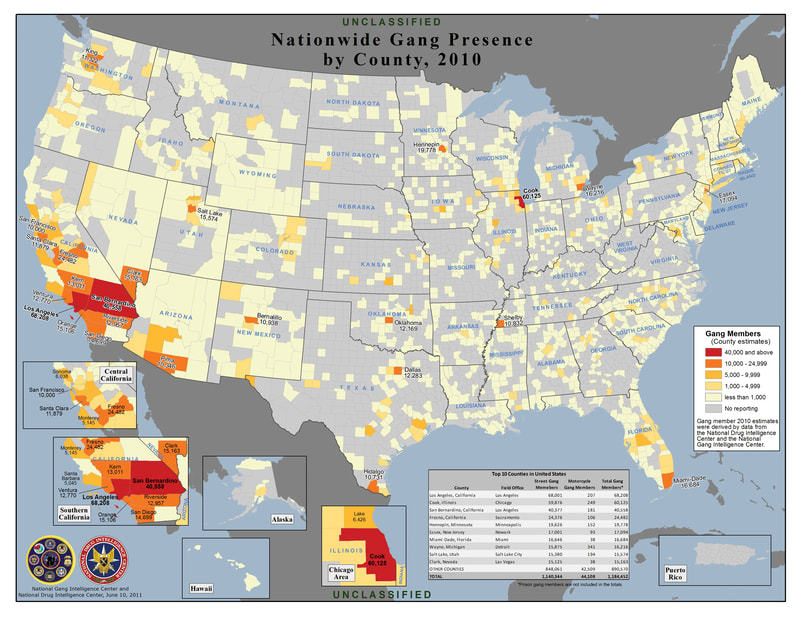Explore Gang Territories & Safety In LA: Interactive Map & Insights
Are you truly aware of the intricate web of influence that street gangs weave throughout our communities? The reality is stark: gang presence isn't just a localized issue; it's a global crisis, impacting everything from neighborhood safety to international security, and mapping these territories is a critical step towards understanding and addressing this pervasive threat.
The task of comprehending and navigating the complexities of gang territories often feels like trying to solve a puzzle with missing pieces. Interactive maps, designed to illuminate the shadowy corners of urban landscapes, offer a crucial perspective. These tools strive to provide insights into gang activities, helping us understand neighborhood safety and the underlying factors that contribute to gang formation and expansion. Law enforcement agencies, too, utilize secured mapping systems, recognizing the need for comprehensive data to combat criminal enterprises.
| Aspect | Details |
|---|---|
| Definition | Street gangs establish control over specific areas, often engaging in criminal activities like extortion and other illegal operations, under the guise of providing protection. |
| Prevalence (US, 2005) | The US Department of Justice reported at least 21,500 gangs with over 731,000 active members in 2005. |
| Formation | Gangs form for a variety of reasons, including socioeconomic factors, the desire for belonging, and a need for protection within vulnerable communities. |
| Territorial Enactment | Gang territories manifest through the urban environment, crack shacks, and the use of physical space and the human body to define and control specific areas. |
| Activity Patterns | Gang activity is localized, following a cyclical pattern of surges and declines. |
| Territorial Claims | Gangs use graffiti, tattoos, and networked communication to establish their presence and contest territory. |
| Economic and Social Implications | Gang involvement has far-reaching consequences, affecting both economic development and social cohesion, and these effects are amplified by globalization. |
| Resource | U.S. Department of Justice |
The global landscape of gang territories is complex, representing a crisis that demands immediate attention. From the bustling streets of Chicago to the neighborhoods of London, the impact of gangs is undeniable. Mapping these territories is not merely an academic exercise but a necessary step in addressing a societal threat.
Chicago, with its diverse and often divided communities, offers a prime example of how gang territories are established and maintained. Maps detailing the Chicago hoods, from the South Side to the West and North Sides, offer a granular view of the city's gang landscape. These maps delve into the historical background of each neighborhood, providing a comprehensive understanding of the factors that have led to the current state of affairs.
However, the accuracy of these maps can be a point of contention. While the intention is to offer clarity, the reality is that such representations are often simplified and, in some cases, incorrect. For instance, comments on mapping projects have pointed out inaccuracies in area sizes and locations, as seen in discussions concerning Waltham Forest. The complexities of territorial claims, the fluid nature of gang affiliations, and the constant shifting of power dynamics make accurate mapping a challenging task.
Beyond simple mapping, digital tools are emerging to help the cause. The "Ox_lib" system, for example, provides a specialized interface for gang members, enabling them to access information and track activities via the "/gangmap" command. The coordinates and colors are incorporated into the map, resulting in an immersive experience that showcases the intricacies of gang life.
- Vegamoviesrs Watch Out Low Trust Free Movies What You Need To Know
- Regal Rog Movie Watch Stream Find Showtimes Now
The process of creating and using these maps involves more than just drawing lines on a digital canvas. The team needs to develop a clear understanding of the intentions behind the data collection, considering both the potential benefits and the risks. The script used to gather and present this information is open-source, meaning that it can be reviewed and adapted by the community.
Community input is critical for improving these maps, and requests have been made to include specific areas, such as the Brayd Oaks and Sharpstown regions in Houston, along with highlighting neighborhoods known for specific gang presence, like Denver Harbor.
The same issues that plague mapping efforts in the United States also affect Europe. Reports detailing gang territories in London have been released, revealing a pattern of open warfare among the gangs. This situation has drawn attention to the growing concerns about rising levels of violence and the need for effective public safety measures.
The impact of gang violence on everyday life can be profound. Residents in affected areas often navigate their daily routines with the constant awareness of territorial boundaries and the potential for conflict. The history of these communities is often intertwined with gang activity. For example, communities like Elmo experienced relative calm for extended periods, but the presence of gangs and the potential for armed confrontations were always present, altering perceptions of safety.
The same phenomenon can be observed in Sacramento, where a long list of gangs and their respective areas exist. Oak Park, a historic community in Sacramento, is one example where gang affiliation has significantly shaped its identity. The presence of gangs can become an ingrained part of the cultural landscape, influencing everything from music and art to the very structure of social networks.
The influence of gang culture is also evident in popular culture. The Grand Theft Auto series, for instance, makes gang warfare a fundamental gameplay feature, highlighting the struggle for territory and the consequences of conflict. This allows for a deeper understanding of the dynamics of gang life.
The control of territory and its defense has always been a key part of the gang lifestyle, the battles can be a defining feature of their existence. A gang war is a type of small war that occurs when two gangs end up in a feud over territory or vendetta.
Gang affiliations vary across regions, and there are distinct differences in the types of gangs that operate in various areas. The Bay Area, for instance, is more associated with "peckerwoods" than with skinheads, a term commonly used to describe white supremacist gangs. The political alignment of the gangs can also be significant.
The origins of street gangs lie within various social movements, as well. Following the citys strong black panther and civil rights movements, the streets began to take over. In areas like the Central District of Seattle, the rise of gangs has been linked to shifts in social dynamics, and the decline of community influence on the streets.
The use of technology also has its role to play. In online games, the ability to engage in turf wars via commands such as "/startturfwar" can simulate the challenges of territorial conflict. These online contests can influence the rankings and create a competitive environment for the players.
The challenges of mapping and understanding gang territories extend beyond the purely technical aspects of data collection. It is the human dimension that adds complexity to the situation. The social ramifications of gang violence and the impact of gang presence must be understood.
| Gang-Related Activity | Implication |
|---|---|
| Recruitment | Gangs recruit young people from vulnerable areas by offering a sense of belonging and protection. |
| Criminal Activity | Gangs engage in a wide range of crimes, including drug dealing, extortion, and violence, contributing to insecurity. |
| Territorial Disputes | Conflicts over territory between rival gangs lead to shootings, and other forms of violence, and can destabilize communities. |
| Social Disruption | Gang activity erodes the fabric of society, instilling fear in the populace. |
| Economic Impact | Gang violence disrupts economic activity, making it more difficult for businesses to operate and thrive in some areas. |
| Social Impact | The constant threat of gang violence limits access to educational opportunities and causes stress on residents. |
The quest for a comprehensive understanding of gang territories is an ongoing effort. Collaborative efforts like the use of mapping from Reddit users and those within the r/hoodmap subreddit, contribute to this process. This collective knowledge has the potential to reshape the discussion about gang presence in communities.
Despite the difficulties in accurately mapping gang territories, the importance of doing so remains clear. It is a vital step in recognizing the severity of the issue. It can assist law enforcement and other organizations in understanding the underlying causes of gang violence and in devising effective strategies to tackle the problem.



Detail Author:
- Name : Claud Carter II
- Username : ledner.fannie
- Email : rosanna.okeefe@king.biz
- Birthdate : 2001-03-18
- Address : 17884 Lebsack Drive New Jennifer, MO 18255-9024
- Phone : +1-820-730-0236
- Company : Swift Inc
- Job : Nuclear Medicine Technologist
- Bio : Harum et culpa mollitia ea vel maiores est. Omnis eveniet quas vitae repellat distinctio. Fugiat dolor harum optio omnis harum ea rerum neque.
Socials
instagram:
- url : https://instagram.com/satterfielda
- username : satterfielda
- bio : Ut saepe perferendis itaque. Deserunt aut quod et expedita rem. Itaque dolorem a quo id et.
- followers : 1736
- following : 2751
twitter:
- url : https://twitter.com/aidan_satterfield
- username : aidan_satterfield
- bio : Dolores odit libero ut expedita distinctio. Id consectetur quis quibusdam non. Rerum hic aut voluptatem adipisci.
- followers : 4254
- following : 2375
facebook:
- url : https://facebook.com/asatterfield
- username : asatterfield
- bio : Hic optio delectus quia voluptatem earum odio.
- followers : 2263
- following : 497